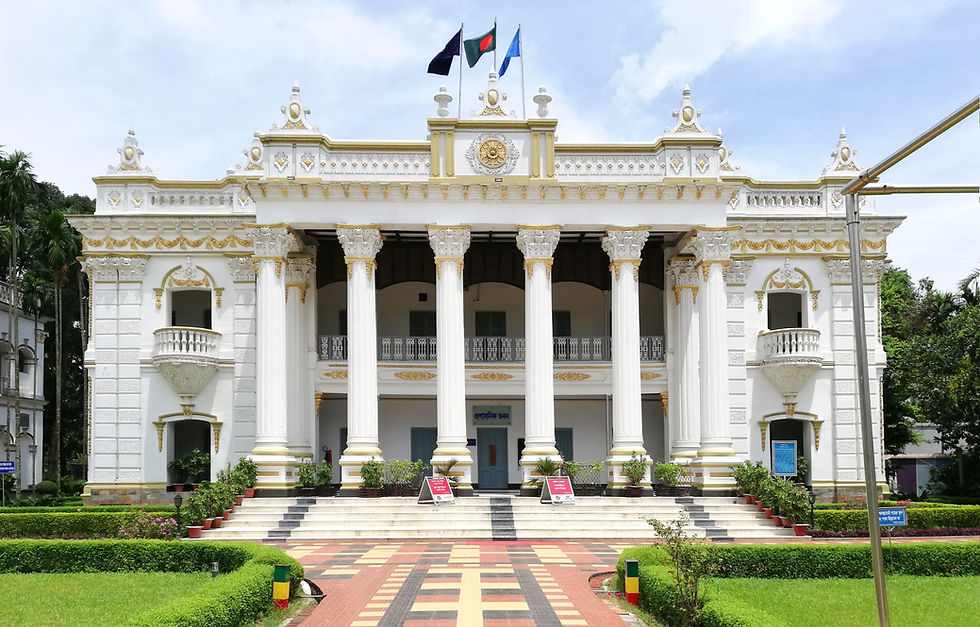Mohera Zamindar Bari Tangail: Glance at Bangladesh’s Zamindari Heritage
- Niharika Momtaz

- Nov 26
- 3 min read

Mohera Jamider Bari, located in the Mirzapur area, Tangail District, Bangladesh, is a fantastic tribute to the Zamindari system that thrived during the British colonial era. This grand mansion, built at the end of the 19th century, is not only an impressive architectural landmark but also an important historical site that reflects the cultural and social dynamism of its time.
Although the site has undergone various transformations over the years, it remains a significant part of Bangladesh’s heritage. However, due to its age and historical significance, some parts of the estate may be under restoration or closed to the public for safety reasons.
Historical Background
The building of Mohera Jamindar Bari Tangail dates back to the 1890s, when two brothers, Kali Charan Saha and Anand Saha, moved from Calcutta. They were mainly involved in trading jute and salt, which earned them a lot of money and eventually helped them acquire huge chunks of land for their zamindari system. The property occupies approximately eight acres of land. It consists of several impressive buildings, including the main house and other lodges, each displaying different styles influenced by Roman, Mughal, and Byzantine architecture.
During the Bangladesh Liberation War in 1971, Mohera Jamider Bari became a scene of sorrow when the Pakistan Army attacked it; during that attack, it led to the killing of five villagers, including the Zamindar’s wife. This was followed by a period of transition for this property, whereby it became a police training school in 1982 before being turned into a training center in 1990.
Architectural Significance
The outstanding architectural grandeur is one of the most remarkable features of Mohera Jamider Bari. The estate has several notable buildings:
Chowdhury Lodge: With its Roman-style columns and detailed design, this pink structure serves as an inviting gateway to the estate.
Ananda Lodge: Ananda Lodge is often described as the prettiest building on the grounds. It features stylish columns with blue and white accents and beautiful gardens filled with sculptures.
Maharaj Lodge: Constructed in the Byzantine style, this lodge has six massive columns that give us an idea of the luxurious life of zamindars.
Kalicharan Lodge: This building is unique because it is designed in an English architectural style shaped like the letter’ U,’ showing that both local and colonial influences blended.
The estate also has beautiful ponds, Bishakha Sagar and Pasra Pond, and colorful flower gardens that enhance its scenic beauty.
Cultural Importance
Mohera Jamider Bari is far beyond a historical site; it symbolizes the culture of the zamindari system in Bangladesh. The estate plays a crucial role in preserving and promoting this culture, allowing visitors to learn about various aspects of life led by the zamindars, including their contribution to local infrastructure like schools and roads. The estate regularly organizes cultural events showcasing traditional Bangladeshi arts and crafts, which makes it an active center for heritage tourism.
Visiting Mohera Zamindar Bari Tangail
It is easy to reach Mohera Jamider Bari if you are traveling from Dhaka. From Moakhali Bus Terminal, buses go directly to Tangail, and local transport is available for the remaining distance to the estate. The most suitable time to visit is between November and February, when the weather is most favorable for exploration.
Guided Tours and Historical Integrity
While enjoying guided tours that provide deeper insights into its rich history and architecture, visitors are requested to respect the property’s historical integrity. Every day, the estate remains open from 10 AM to 6 PM, even though there may be sporadic closures due to maintenance or special events.
In summary, Mohera Jamider Bari remains an important location on Bangladesh’s historical map. It boasts incredible architecture and a rich cultural heritage, making it a place one should visit to explore zamindari life in Bangladesh. Mohera Jamider Bari is a museum for architectural enthusiasts and history lovers, holding their breath and longing for such experiences.




Comments